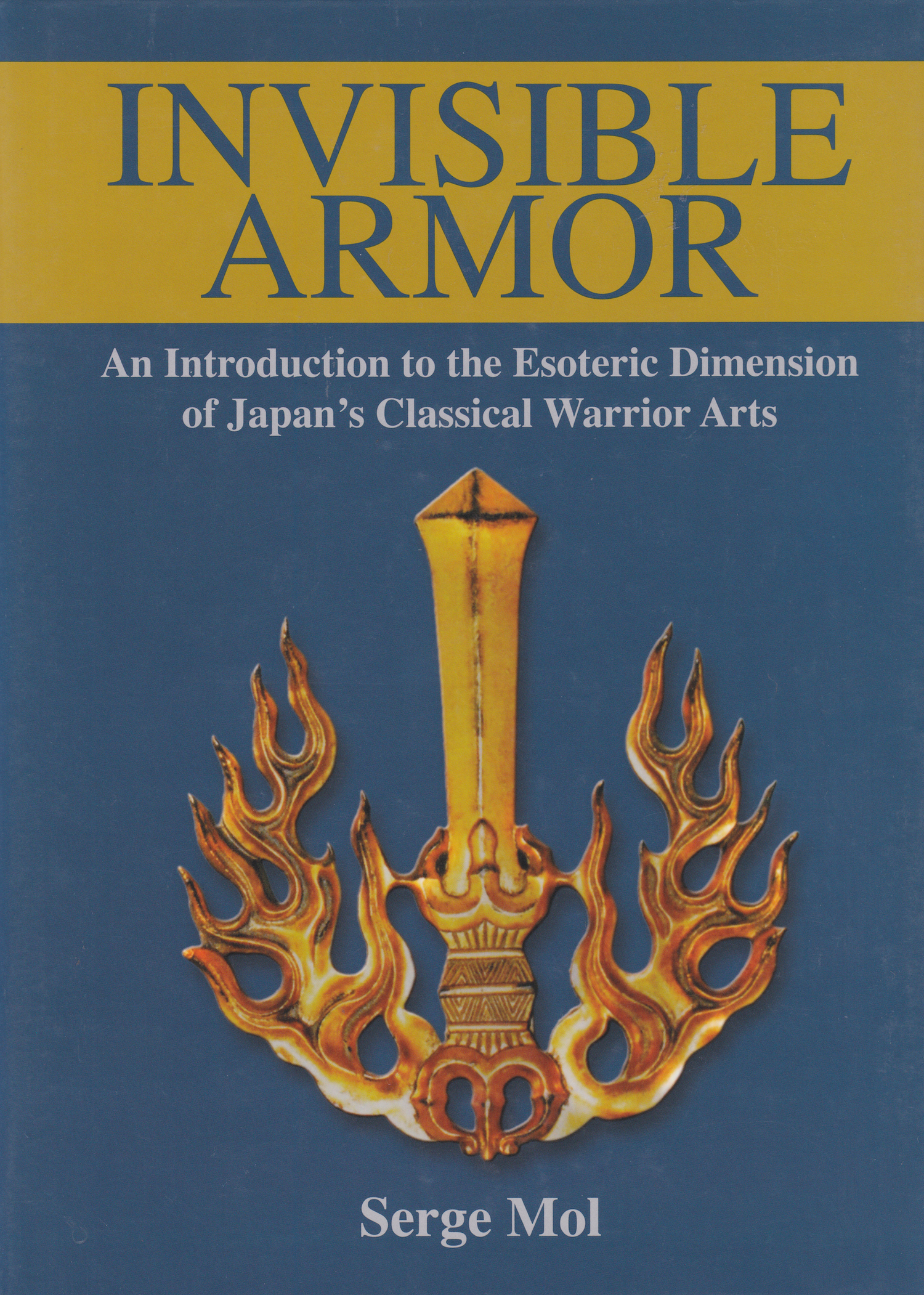Invisible Armor: Intro to Japan's Esoteric Warrior Arts Book by Serge Mol (Haardcover) (Preowned)
In Invisible Armor, martial arts historian and author Serge Mol, introduces the reader to the esoteric dimension to the art of war, and by doing so paints a completely different picture of the Japanese warrior than the traditional Zen inspired image most readers have grown accustomed to.
With well over a hundred carefully selected photographs and illustrations, this volume not only helps the reader visualize, but also as it were brings back to live. the ancient spiritual methods and esoteric doctrines the warrior or bushi relied on in combat, ranging from personal protection rituals and secret spells, the usage of various types of charms to methods of divination intended to influence the outcome of war.
In this comprehensive work, Mol includes an in-depth discussion of some relatively well known. but often misunderstood personal spiritual means of protection such as Kuji Kirl and juino, which at present are mostly associated with the bushi's anti pole, the ninja, and explains how the warrior secret employed these very methods in various routine activities. Furthermore Mol also introduces the methods used on a much larger scale, by the classical warlord and his advisor the gunbaisha or gunshi, to choose suitable days and directions for going to war or how to find auspicious locations to build castles and fortifications, or how to read the ki or energy of an enemy army to find out whether the time for a full scale assault on it had come or not.
This exhaustive volume will provide the reader access to a wealth of information hitherto unavailable in English. As with Mol's earlier works, Invisible Armor, is almost exclusively based on original Japanese source material, including once secret manuscripts of martial arts traditions, ancient texts on strategy, old battle chronicles and so on. In his selection of source documents Mol has not limited himself to works more typical for the bushi or samurai figure, but has also borrowed extensively from ninja related documents such as Bansenshükai, Ninpiden, and Shoninki to mention only the better known ones.
Using passages from these works, and comparing them with books on samurai or bushi strategy, including Koyd Gunkan, Shikansho, Bukyo Zensho, and so on the author demonstrates that often ninia and bushi relied on the same esoteric methods and strategies. Because of its unique scope and depth, Invisible Armor: An Introduction to the Esoteric Dimension of Japan's Classical Warrior Arts, will not only be of great interest to enthusiasts of both samurai and ninja history and culture, but also to the more serious practitioner of an Japanese martial art.
Table of Contents
Introduction
1. Spiritual Means for Personal Protection
Goshinpo
The three secrets, or the significance of mudra, mantra and mandala
The symbolism behind the goshinpo ritual
Other Protection Rituals and Related Methods
2. Kujiho
The Origin of Kujiho
The Symbolism Behind Kujiho in General
Kuji In
The symbolism of kuji in's nine seals
Kuji Kiri
Kuji san's kuji grid
Kuji Modoshi and Kuji Yaburi
3. Jujiho
Marishitenho
The secret strategy of Minamoto no Yoshitsune
Yoshitsune's training on Mount Kurama
4. The Ninja's Spiritual Arsenal
The Skinification of Marishiten to the Ninja
Marishiten and the ninja's art of invisibility
Sanmyaku Goshinpo
Kan Man Horohon
Ninja Protection Charms
Izuna no ho and the Izuna charm
The Izuna charm
Sannoki's ninja charms
Inko Ryu's "ninja magic"
The Shuriken, with its Hidden Symbolism, Weapon and Good Luck Charm at the Same Time?
5. Protection Charms, Talismans and Other Means to Ward Off Danger
Protection Charms
Charms for Battlefield Combat
The warrior's armor as a means of warding off bad luck
Importance of the Colors of one's Armor, Favorable and Unfavorable Armor
Gasoku no mamori
Symbolism of an Even More Esoteric Nature
The Japanese bow and its hidden symbolism
The Saihai
Esoteric Symbols Present in the Inner Battle Camp
Jin no maku and hata
Skinification of Colored Ropes in the Tying Arts
Colored ropes as a means of invoking divine protection?
6. Spiritual and Psychological Weaponry
Spiritual Weaponry
Kuji and Juji as Psychological Weapons
The Usage of Mudra in Combat
Fudokanashibari
The meaning of Fudokanashibari from a Mikkyō perspective
Feasibility of kanashibari in combat
The Mysterious Power of Shin no Ippo
7. The Esoteric Dimension of the Art of War
The Gunbaisha or Gunshi
Gunbaho
Hidori
Hidori based on the days of the year
Hidori based on the Five Natures
Hōdori
Hidori and Hōdori combined
Kataimi and Kataiagae
The Gunbai
Goki
8. Shutsujin Rituals
Mikkyō Based Shutsujin Kinen
Attack: Win! Rejoice!
Shutsujin on an Inauspicious Day
Shutsujin and Superstition
War and the Power of Mind Control
Taira no Kiyomori's usage of Tachikajiri, a pretext to reign in his men and avoid unnecessary casualties?
Oda Nobunaga's victory against the odds
9. The Esoteric Side of Building Castles and Fortifications
About Chiso, Kaso and Chikujoutsu
Shijin Soyo, the Protection of the Four Guardian Deities
Heian Kyo, the capital protected by the gods
The Significance of the Dragon Lines
The Nature of Land and Castle
Fusui, the Secret Key to 260 Years of Tokugawa Rule?
Appendix
Inyo (Yin and Yang)
Gogyo (The Five Elements)
Gogyo Sokoku (The Destructive Relationship of The Five Elements)
Gogyo Sojo (The Creative Relationship of The Five Elements)
Inyo-Gogyo (Yin and Yang and The Five Elements)
Junishi (Twelve Zodiac Animals)
Jūnishi in relation to direction and time
Jikkan (Ten Celestial Stems)
Kanshi or Eto Calendar
Gosei (The Five Natures)
Nijūhasshuku (Twenty-Eight Constellations)
Nijūhasshuku chart
Tōeki (Ji "I")
Kyūseijutsu (Nine Star Divination)
Hakke (Eight Trigrams)
Table of Kōchijutsu or Yakubi days
List with lucky days for shutsujin
Taishibisei
The method of the fox and the unguarded direction
Notes
Bibliography
ABOUT THE AUTHOR:
Serge Mol is one of the foremost Western authorities in the field of Japan's traditional martial arts. He started his martial arts training some thirty years ago and presently holds the ranks of menkyo and menkyo kaiden in a number of classical schools. His earlier publications Classical Fighting Arts of Japan: A Complete Guide to Kory Jujutsu and Classical Weaponry of Japan: Special Weapons and Tactics ot the Martial Arts -both best sellers-- have set completely new standards in their genre
Mol lived in Japan for several years, devoting most of his time to training and research. Having lived in Japan as a member of a traditional Kyoto family of samurai origin has provided him with a unique perspective on the subject. Additionally Mol has an extensive collection of Edo period documents about martial arts, weaponry and samurai and ninja history and culture.
Length: 160 pages
Publication date: 2008
Couldn't load pickup availability


